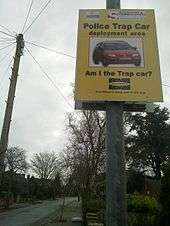Bait car
A bait car, also called a decoy car, hot car or trap car, is a vehicle used by law enforcement agencies to capture car thieves or thieves who steal items from cars.[1] The vehicles are modified with audio/video surveillance technology, and can be remotely monitored and controlled. Those set up to catch car thieves may include GPS tracking. A "kill switch" may be installed in the vehicle allowing police to remotely disable the engine and lock all doors remotely, preventing escape. A car set up to catch thieves who steal items from cars may be disabled so that it cannot be started and have specially prepared "bait property."

Overview
The bait car, often filled with valuable items to draw attention to it, is typically parked in a high auto-theft area. In usual cases, the vehicle is simply left unlocked with the keys in the ignition.[2] If the car is set up to catch car thieves, when the car is stolen officers are immediately alerted, and can monitor the vehicle and send commands to control it such as disabling the engine, locking the doors or honking the horn. Live audio/video streaming devices may be installed allowing law enforcement personnel to determine how many suspects are in the car, what they are planning and if they are armed.[3] If the bait car is set up to catch thieves who steal items from cars, it may be monitored by video from a central location. The bait property, such as a tool kit or gym bag, will also be set up so it can be tracked and monitored.
Bait cars can be used as part of a honey trap, a form of sting operation, in which criminals not known to the police are lured into exposing themselves. Unlike a sting operation that targets a known or suspected criminal, a honey trap establishes a general lure to attract unknown criminals. Bait cars are not considered entrapment because they merely afford criminals the opportunity to steal the car; entrapment, on the other hand, constitutes law enforcement persuading or encouraging a person to commit a crime that they would not have committed otherwise.
By location
British Columbia
The largest bait car fleet in North America, which employs the Minneapolis model, is operated by the Integrated Municipal Provincial Auto Crime Team (IMPACT), based in Surrey, British Columbia. Surrey was designated the "car theft capital of North America" by the Royal Canadian Mounted Police in 2002.[4] Their bait car program was launched in 2004, and has contributed to a 55% drop in auto theft since then.[5]
Minnesota
In 2010, the Anti-Vehicle Crime Association of Minnesota presented an award to the Minneapolis Police for its Bait Vehicle Program, which had been running for twelve years at the time.[6] In 2002, the Minneapolis program inspired a similar project in Essex in the United Kingdom.[7]
In mass media
Bait cars (and the stings they are used in) have been featured in numerous documentary and reality television programs, including COPS, World's Wildest Police Videos, and Jacked: Auto Theft Task Force. They were also the exclusive focus of the TruTV television series Bait Car.[8]
References
- Bait Car Program Now Includes Theft From Vehicles Archived 2015-02-19 at the Wayback Machine
- "Police department using bait to catch car thieves in the act". 12 December 2008.
- Car thieves beware: You might find yourself on candid camera Archived 2009-05-17 at the Wayback Machine
- CTV News article
- IMPACT Autotheft Prevention. Archived 2009-04-07 at the Wayback Machine
- "Minneapolis Police's Bait Vehicle Program Recognized". Archived from the original on 2011-07-08. Retrieved 2010-12-31.
- "Decoy car to trap thieves". 16 May 2002 – via bbc.co.uk.
- "truTV - Reality TV - Comedy". Archived from the original on 2009-08-31. Retrieved 2009-05-02.
External links
| Wikimedia Commons has media related to Bait car. |
- BaitCar.com - Official website of IMPACT's bait car program in British Columbia. Includes on-board videos of bait cars being stolen.